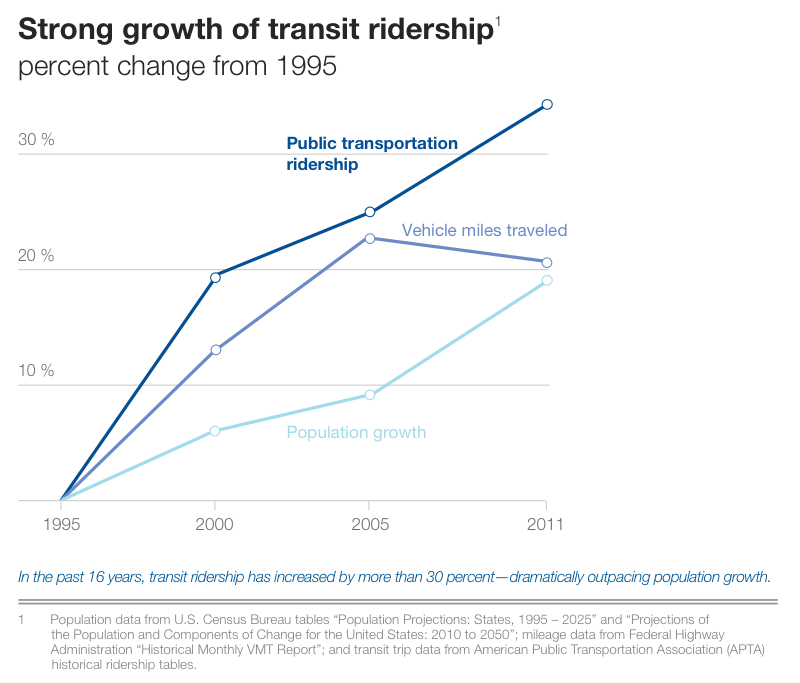TRANSPORTATION FOR AMERICA
Introduction
The demand for public transportation service is at its highest point in 50 years. The causes are many: rising gas prices, an increasingly urbanized population, growing numbers of seniors, and the preferences of the “millennial” generation. These factors and more are contributing to soaring ridership on existing transit routes. And more communities today are looking for funds to build and operate rail and bus lines than ever before.
Communities are looking to mass transit as a way to achieve their vision for the future. At the same time, conventional sources of funding are harder to obtain. A combination of ideological gridlock in Congress, dwindling federal gas tax revenues, and the elimination of earmarks have made traditional approaches to building transit more challenging.2 Despite these obstacles, many communities are finding creative ways to move ahead.
This guidebook is designed to help community leaders get from Point A—the desire to meet the demand for transit—to Point B—raising the money needed to build and operate it.
Communities of all sizes are planning and designing streetcars, rapid busways, light rail, commuter rail, and other so-called “fixed guideway” systems because they move a lot of people, while doing a lot more than that. These lines can shape development so that growth and change will improve—and not harm—existing neighborhoods and quality of life. Such development generates a higher level of tax revenues per acre than traditional, low- density development. This is especially true when transportation planners work with other public agencies and the private sector to grow walkable neighborhoods around transit stations.
Transit helps to maintain the efficiency of the existing road network, because every transit rider is one person not traveling by car. A city bus can carry more than 60 people and a full train more than 1,600, meaning that high-capacity busways and rail lines can carry the equivalent of seven highway lanes or seventeen lanes of urban street.3 That helps communities avoid the disruptive and expensive cycle of road-widening that never seems to solve congestion for long.
A good transit system also saves people money. When all the costs of car ownership are accounted for—purchase price, finance charges, insurance, gas, repairs, etc.—it eats up a big slice of the family budget. Transit can give people the option to use their cars less, buy less gas, or own fewer cars.
Growing public interest in transit is leading many communities to look for ways to expand their offerings. Many of the metropolitan regions with transit today—Atlanta, Dallas, Salt Lake City, Denver, Phoenix, and Minneapolis to name a few— received significant federal money through the U.S. Department of Transportation New Starts program, which provides funding to cover the construction or expansion of fixed-guideway transit systems. Now many other communities are hoping to follow their lead and expand transit.
As more communities seek to develop or expand transit systems, this already over-subscribed program will not be able to fund every project seeking assistance. To make the money go further, the program has recently covered one-half of project costs, down from 80%, with some projects getting as little as a one-third from New Starts. Even with this policy in effect the waiting list grows longer every year. A city hoping to get a New Starts grant should be prepared to wait 10 years until project completion. With the current political environment in Congress, it is unlikely that transportation funding, including New Starts, will increase for the next several years.
But all is not lost. There are ways to pay for new transit investments without waiting so long, and a growing number of communities are pursuing them. But doing so requires more sophistication in the art of project finance than has been needed in the past. Someday—soon, we hope—the Federal Government may respond to the high level of demand for new transit investments by increasing funding available to communities. Those of us who aspire to provide these options for people in our communities must continue to work toward that goal. In the meantime, though, we can demonstrate the depth of the need and the strength of our desire by finding our own creative ways to make these projects happen. This guidebook is a first step toward that goal.
Read full guidebook (PDF) here: Thinking Outside the Farebox
About Transportation for America
www.t4america.org
Transportation for America has formed a broad coalition of housing, business, environmental, public health, transportation, equitable development, and other organizations. We’re all seeking to align our national, state, and local transportation policies with an array of issues like economic opportunity, climate change, energy security, health, housing and community development.
Tags: Fares, Finance, Transit, Transportation for America







 RSS Feed
RSS Feed